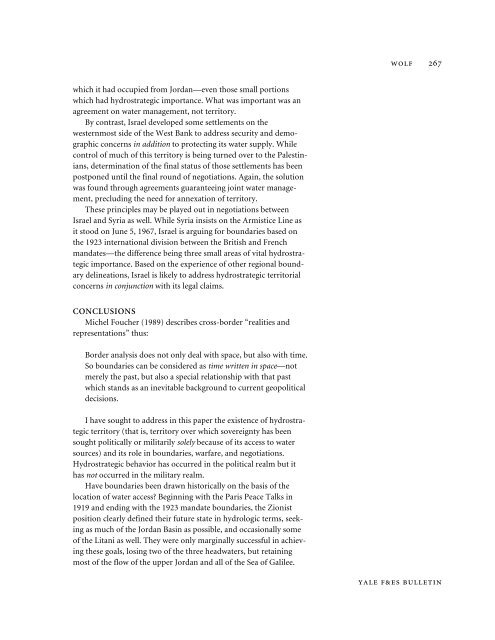266 MIDDLE EASTERN NATURAL ENVIRONMENTSHeights. As mentioned above, Schwartz <strong>and</strong> Zohar (1991) advisedIsraeli retention of <strong>the</strong> Golan Heights west of <strong>the</strong> Jordan River watershedline in order to guarantee continued control of both waterquantity <strong>and</strong> quality (see Figure 13). In a 1994 study, Shalev (1994),himself a retired general in <strong>the</strong> Israeli army, cites five o<strong>the</strong>r retiredgenerals on <strong>the</strong> importance of Israeli sovereignty over <strong>the</strong> Golan to<strong>the</strong> protection of water resources. Even in his small sample, Shalevfinds a range of military opinions, from those who suggest thatIsrael retain a physical presence on <strong>the</strong> Golan Heights, to those whoadvocate retention of at least <strong>the</strong> plateau above <strong>the</strong> Sea of Galilee, tothose (such as former Chief of Staff Mordechai Gur) who argue that<strong>the</strong> water problem can be resolved politically in a peace treaty, <strong>and</strong>that <strong>the</strong> territory is not vital. Shalev concludes that Syria would notrisk a war with Israel for water, especially since a diversion wouldtake years to construct <strong>and</strong> would constitute a clear casus belli. Itst<strong>and</strong>s to reason, Shalev argues, that countries involved in watersharingagreements would want to maintain <strong>the</strong>m.In <strong>the</strong> meantime, Schiff (1995), Tarnopolsky (1996), <strong>and</strong> o<strong>the</strong>rshave argued in <strong>the</strong> popular Israeli <strong>and</strong> Jewish press that water’sparamount importance may scuttle negotiations over <strong>the</strong> Golan,while Israeli politicians from <strong>the</strong> Labor party, including Prime MinisterShimon Peres <strong>and</strong> his Foreign Minister Ehud Barak, argue thatwhile <strong>the</strong> l<strong>and</strong> may be negotiable, <strong>the</strong> water is not (Jerusalem Post,January 6, 1996 <strong>and</strong> January 27, 1996).In answer to <strong>the</strong> question posed at <strong>the</strong>beginning of this section, “How much of<strong>the</strong> quest for negotiated boundaries hasbeen influenced by <strong>the</strong> location of waterresources?” <strong>the</strong> evidence seems tosuggest: not much. This is not to say thatwater has not been an important topic ineach set of negotiations—quite <strong>the</strong>opposite. The questions of waterallocations <strong>and</strong> rights have been intricate<strong>and</strong> have been only partially resolved,<strong>and</strong> even so with great difficulty.Water <strong>and</strong> Negotiations—ConclusionsIn answer to <strong>the</strong> question posed at <strong>the</strong> beginning of this section,“How much of <strong>the</strong> quest for negotiated boundaries has been influencedby <strong>the</strong> location of water resources?” <strong>the</strong> evidence seems tosuggest: not much. This is not to say that water has not been animportant topic in each set of negotiations—quite <strong>the</strong> opposite. Thequestions of water allocations <strong>and</strong> rights have been intricate <strong>and</strong>have been only partially resolved, <strong>and</strong> even so with great difficulty.Never<strong>the</strong>less, with <strong>the</strong> concluded negotiations between Israel <strong>and</strong>Jordan <strong>and</strong> <strong>the</strong> ongoing talks between Israel <strong>and</strong> <strong>the</strong> PalestinianAuthority (<strong>and</strong> despite <strong>the</strong> quantity of studies identifyinghydrostrategic territory <strong>and</strong> advising its retention) no territory todate has been retained simply because of <strong>the</strong> location of water. Solutionsin each case have focused on creative joint management of <strong>the</strong>resource, ra<strong>the</strong>r than insistence on sovereignty.The pattern which does seem to be emerging, however, is thatwater in addition to one or more o<strong>the</strong>r concerns, may justify retentionof territory. For example, in <strong>the</strong> absence of any legal claims,security interests, or settlements, Israel withdrew from territoryBULLETIN 103
WOLF 267which it had occupied from Jordan—even those small portionswhich had hydrostrategic importance. What was important was anagreement on water management, not territory.By contrast, Israel developed some settlements on <strong>the</strong>westernmost side of <strong>the</strong> West Bank to address security <strong>and</strong> demographicconcerns in addition to protecting its water supply. Whilecontrol of much of this territory is being turned over to <strong>the</strong> Palestinians,determination of <strong>the</strong> final status of those settlements has beenpostponed until <strong>the</strong> final round of negotiations. Again, <strong>the</strong> solutionwas found through agreements guaranteeing joint water management,precluding <strong>the</strong> need for annexation of territory.These principles may be played out in negotiations betweenIsrael <strong>and</strong> Syria as well. While Syria insists on <strong>the</strong> Armistice Line asit stood on June 5, 1967, Israel is arguing for boundaries based on<strong>the</strong> 1923 international division between <strong>the</strong> British <strong>and</strong> Frenchm<strong>and</strong>ates—<strong>the</strong> difference being three small areas of vital hydrostrategicimportance. Based on <strong>the</strong> experience of o<strong>the</strong>r regional boundarydelineations, Israel is likely to address hydrostrategic territorialconcerns in conjunction with its legal claims.CONCLUSIONSMichel Foucher (1989) describes cross-border “realities <strong>and</strong>representations” thus:Border analysis does not only deal with space, but also with time.So boundaries can be considered as time written in space—notmerely <strong>the</strong> past, but also a special relationship with that pastwhich st<strong>and</strong>s as an inevitable background to current geopoliticaldecisions.I have sought to address in this paper <strong>the</strong> existence of hydrostrategicterritory (that is, territory over which sovereignty has beensought politically or militarily solely because of its access to watersources) <strong>and</strong> its role in boundaries, warfare, <strong>and</strong> negotiations.<strong>Hydrostrategic</strong> behavior has occurred in <strong>the</strong> political realm but ithas not occurred in <strong>the</strong> military realm.Have boundaries been drawn historically on <strong>the</strong> basis of <strong>the</strong>location of water access? Beginning with <strong>the</strong> Paris Peace Talks in1919 <strong>and</strong> ending with <strong>the</strong> 1923 m<strong>and</strong>ate boundaries, <strong>the</strong> Zionistposition clearly defined <strong>the</strong>ir future state in hydrologic terms, seekingas much of <strong>the</strong> Jordan Basin as possible, <strong>and</strong> occasionally someof <strong>the</strong> Litani as well. They were only marginally successful in achieving<strong>the</strong>se goals, losing two of <strong>the</strong> three headwaters, but retainingmost of <strong>the</strong> flow of <strong>the</strong> upper Jordan <strong>and</strong> all of <strong>the</strong> Sea of Galilee.YALE F&ES BULLETIN
















